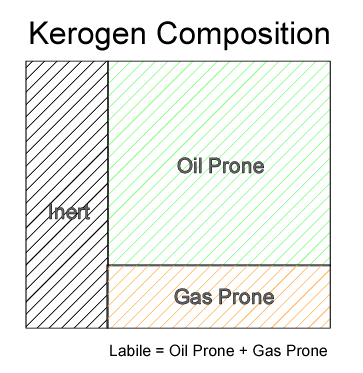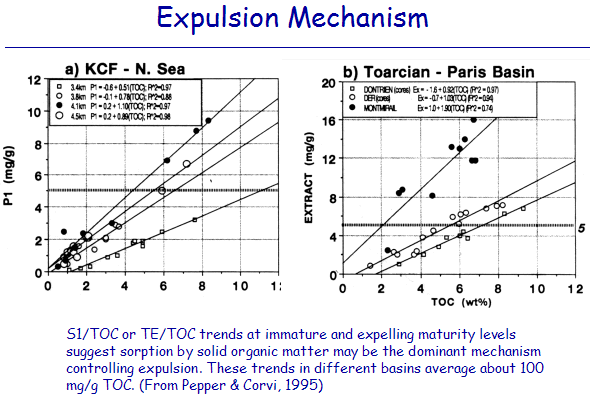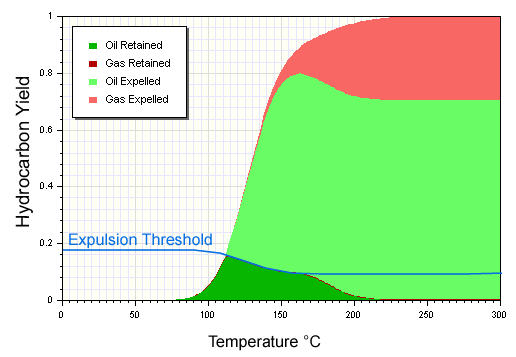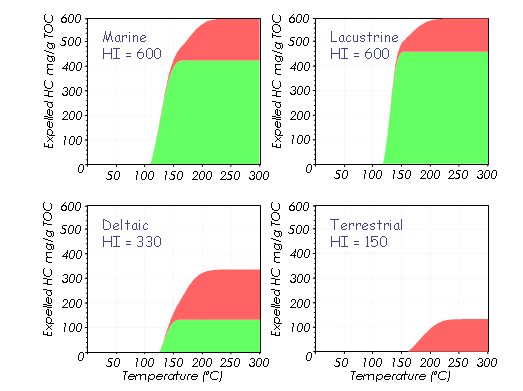| Hydrocarbon Generation And Expulsion |
| Kinex main page | Simple tutorial | Reservoir cracking | Shale Play Example | FAQ | What Is New? |
Kerogen composition
Not all the kerogen (solid organic matter) in source rocks can be converted to hydrocarbons. There will be some dead (inert) carbon left in the end. The part that can be converted to hydrocarbons is called labile component. Part of the labile component gets converted to oil (the oil prone part) and part of it converts to gas (gas prone part). The gas prone fraction, gas prone/(gas prone+oil prone), range from about 15% in marine or lacustrine kerogens to about 50% in terrestrial kerogens. Some times people use the term GOGI (gas prone/oil prone). The Rock Eval parameter Hydrogen Index (HI) measures how much labile component a kerogen has. HI is all the labile component divided by all the carbon in the kerogen (mg HC/TOC). Higher HI source rocks produce more hydrocarbons per unit TOC.

Generation Potential of Kerogen
Here are some useful parameter for describing the generative potential of source rocks:
- TOC = organic carbon content (percent weight) of source rock.
- S1 (mg/g rock) Liquid hydrocarbon residual measured during Rock Eval (peak 1)
- S2 (mg/g rock) Liquid hydrocarbon generated by Rock Eval (peak 2)
- HI = S2/TOC (mg HC/g TOC) --- describes how much of the organic matter can be converted to hydrocarbons.
- PI = S1/(S1+S2) a measure of maturity.
- TI = S1/TOC (mg/g TOC), represents existing hydrocarbons before source rock matures.
- GOGI = Gas Prone / Oil Prone mass ratio (1.0 = 50% gas, 0.5 = 33% gas, 0.2 = 17% gas potential)
What About Expulsion ?
Expulsion of oil from solid organic matter (kerogen) into porosity of the source rock is believed to be controlled by adsorption. If enough hydrocarbons are generated and the kerogen is saturated, the additional HC fluids will expel into the pore system. If the pore system is dominated by fine grained water wet clay minerals, it stores very little oil or gas before they are expelled from the source rock into a carrier bed. The second stage us usually called primary migrationThe default expulsion model in Kinex relies on the empirical observation that the quantity of liquid hydrocarbon residual (unexpelled by definition) as measured by Rock Eval in the source rock seems to correlate very well with the amount of solid organic matter (see figures below) for a given maturity level.

The correlation is usually very good and the maximum gradient seems to be around 100 mg per gram of TOC in terms of Rock Eval measurements (usually the range could be between 80 and 120). This observation seem to indicate that the sorption (adsorption and absorption) may be responsible for retaining most of the residual hydrocarbons in these source tocks, perhaps because in these source rocks the pore system is dominated by clay minerals. The water wet clays have very small inter granular pores and the capillary pressure does not allow high saturation of the non-wetting phase. If the source rock contains silty interbeds, the porosity in the source rock interval may retain significant volumes. The additional consideration is discussed in this tutorial .
The formular for calculating volumes of hydrocrbon expelled from kerogen is given by:
Volume expelled (per unit area) = H·(HI·Tr·(1-G0) - S·Ci)·TOC·rr/ro where:
H ---- thickness of source rock,Ci may be calculated as Ci = 1-HI·Tr·0.85/1000.It is an assumption we make that the sorption of hydrocarbons is only by the solid organic matter. This term dictates that sorption capacity will decrease as a function of maturity and with low HI source rocks, the decrease is slower. The expelled volume is zero when the terms in the parenthesis evaluates to less than zero. Most of the parameters required above are defined for each source rock, while the transformation ratio is calculated for each grid cell. Maps of source thickness, HI and TOC can also be used for each source rosk.
rr ---- density of source rock,
ro ---- density of oil,
HI ---- hydrogen index,
Tr ---- transformation ratio,
G0 ---- initial gas prone fraction (fraction of the total initial that is gas generative) = GOGI/(1+GOGI),
TOC ---- total organic carbon,
S ---- sorption capacity for oil or gas, for example, 100 mg/gTOC for oil and 20 mg/gTOC for gas.
Ci ---- the fraction of inert carbon.
What ever the reason, the practical matter is that we could use the magic number 100g/g TOC as the approximate limit for expulsion. Genesis uses a more sophisticated formula that relates sorption to the molar weight of the hydrocarbons since heavier components tends to be preferentially absorbed. WHen the amount of hydrocarbons generated exceeds the magic number, it starts to expel. Total sorption will decrease as solid kerogen is converted to liquid petroleum as shown in the next figure.

Gas or oil ?
Obviously kerogens with higher gas prone fraction (or GOGI) may generate a bit more gas. Typically marine and lacustrine source rocks have lower GOGI (<0.2 or less than 17%) and deltaic and fluvial source facies have higher GOGI (~1.0 or 50%) and generate more gas. But in general, even the so called gas prone source rocks generate about 50% of its potential as oil. The more important control on oil vs gas expelled is actually the hydrogen index (HI). the higher the total labile component is (higher HI), more of the oil expels as oil. Because the D/E and F facies have lower HI, most or all of the oil will not be expelling until it is cracked to gas in the source rock. Kerogens seem to retain about 100 mg/g TOC (in HI unit) of the labile material due to sorption. If the oil generaton potential is less than this amount, the soruce rock will only expel gas. So the lower the HI, the higher the relative proportion of 100 is of the HI, the more gas we get as a result of expulsion. For example, if the total HI is 150 mg/g TOC, and GOGI is 1.0, the oil potential is only 75 mg/g, less than the sorption capacity of kerogen, only gas can ne expelled, even though 50% of the labile material is oil prone.

References:
- Pepper, A. S., 1991, Estimating the petroleum expulsion behavior of source rocks: a novel quantitative approach: in W. A. England, and A. J. Fleet, ed., Petroleum migration: The Geological Society Special Publication 59: London, p.9-31.
- Pepper, A. S., and P. J. Corvi, 1995, Simple kinetic models of petroleum formation. Part I: oil and gas generation from kerogen : Marine and Petroleum Geology, v. 12, p.291-319.
- Pepper, A. S., and T. A. Dodd, 1995, Simple kinetic models of petroleum formation. Part II: oil-gas cracking : Marine and Petroleum Geology, v. 12, p.321-340.
- Pepper, A. S., and P. J. Corvi, 1995, Simple kinetic models of petroleum formation. Part III: Modelling an open system : Marine and Petroleum Geology, v. 12, p.417-452.
©2001-2004, ZetaWare, Inc. All rights reserved